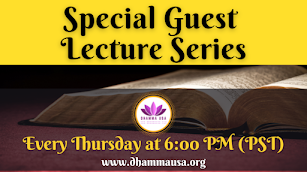Mindful Nourishment: Understanding Āhāra Paccavekkhanā in Buddhist Practice
By Bhante Sumitta
In the rich tapestry of Buddhist contemplative practices, few are as immediately relevant to daily life as āhāra-paccavekkhaṇā — the mindful reflection on food. This fundamental practice, deeply embedded in the monastic tradition and equally valuable for lay practitioners, transforms the simple act of eating into a profound spiritual exercise that cultivates wisdom, moderation, and awareness.
The Practice Defined
Āhāra-paccavekkhaṇā literally translates as "reflection on food" or "contemplation of nourishment." The practice involves a deliberate, mindful consideration of one's relationship with food before, during, and after eating. Rather than consuming meals habitually or for mere pleasure, practitioners engage with nourishment as a conscious spiritual act that supports both physical well-being and mental cultivation.
The traditional reflection, preserved in the Pali Canon, provides a clear framework for this contemplation:
"Wisely reflecting I use this almsfood, not for fun, not for pleasure, not for beauty, not for adornment. Only for the nourishment and health of this body and sustaining my spiritual practice. I will eliminate old unpleasant feelings and I will not produce new unpleasant feelings. In this way I will be blameless and comfortable."
This reflection encapsulates the essence of the practice: approaching food with wisdom (*yoniso*), understanding its true purpose, and maintaining awareness of how eating affects both body and mind.
Historical and Textual Context
The practice of āhāra-paccavekkhaṇā finds its roots in the earliest Buddhist texts, particularly within the Vinaya (monastic code) and various suttas that address mindfulness in daily activities. For monastics, this reflection traditionally accompanies the receipt and consumption of alms food, serving as a reminder of the donation's sacred nature and the practitioner's commitment to using offerings wisely.
The Buddha emphasized the importance of moderation in eating, teaching that food should be consumed with awareness and restraint. In the *Majjhima Nikaya*, he frequently addressed the middle way approach to nourishment — neither indulgence nor extreme asceticism, but a balanced understanding of the body's genuine needs.
The Four Negations: What Food Is Not For
The traditional reflection begins with four explicit negations that help practitioners recognize and abandon unwholesome motivations for eating:
Not for fun (na davāya): This addresses the tendency to eat purely for entertainment or sensory stimulation. While acknowledging that food can be enjoyable, the practice encourages moving beyond eating as mere amusement or distraction.
Not for pleasure (na madāya): Here, madāya suggests intoxication or excessive indulgence. The reflection reminds practitioners not to use food as a source of intoxication or as a means to chase heightened pleasurable states that cloud mindfulness.
Not for beauty (na maṇḍanāya): This negation addresses eating motivated by vanity or the desire to enhance physical appearance through food choices driven primarily by aesthetic concerns rather than genuine nourishment.
Not for adornment (na vibhūsanāya): Similar to beauty, this refers to using food consumption as a way to decorate or embellish oneself, perhaps through fashionable dietary trends or status-driven food choices.
These four negations work together to help practitioners recognize and release attachment to unwholesome motivations, creating space for more skillful relationship with nourishment.
The Positive Purpose: True Nourishment
After establishing what food is not for, the reflection turns to its authentic purposes:
Physical maintenance (kāyassa ṭhitiyā): Food serves the fundamental purpose of maintaining bodily health and strength. This recognition honors the body as the vehicle for spiritual practice while avoiding both neglect and excessive attention to physical needs.
Harm prevention (vihiṃsūparatiyā): Proper nourishment prevents the harm that comes from both overeating and undernourishment. This aspect emphasizes the Buddha's middle way approach, avoiding the extremes that can damage both physical and mental well-being.
Supporting spiritual practice (brahmacariyānuggahāya): Perhaps most significantly, food consumption should support one's spiritual development. This transforms eating from a merely biological function into an act that serves the higher purpose of awakening.
The Vedana Connection: Managing Feelings
The reflection's reference to "purānañca vedanaṃ paṭihaṅkhāmi, navañca vedanaṃ na uppādessāmi" (eliminating old unpleasant feelings and not producing new unpleasant feelings) reveals the practice's sophisticated understanding of the relationship between eating and emotional states.
Vedanā, or feeling-tone, represents the immediate pleasant, unpleasant, or neutral quality that accompanies every experience. Through mindful eating, practitioners can:
- Recognize how hunger creates unpleasant feelings and how appropriate nourishment can address these feelings without overindulgence
- Avoid creating new unpleasant feelings through overeating, eating unwholesome foods, or eating with unwholesome motivations
- Maintain equanimity with the pleasant feelings that naturally arise from satisfying hunger, neither clinging to nor rejecting these experiences
The Triple Outcome: Blameless, Comfortable Living
The reflection concludes with three desired outcomes:
Survival/Sustenance (yātrā): Meeting the basic need for nourishment to continue living and practicing.
Blamelessness (anavajjatā): Eating in a way that causes no harm to oneself or others, maintaining ethical purity in food consumption.
Comfortable dwelling (phāsu vihāro): Achieving a state of physical and mental ease that supports meditative practice and spiritual development.
Practical Application
For contemporary practitioners, āhāra-paccavekkhaṇā offers practical benefits that extend far beyond traditional monastic contexts:
Mindful consumption: The practice naturally develops awareness of eating habits, helping practitioners recognize patterns of emotional eating, overconsumption, or unconscious consumption.
Ethical consideration: Reflecting on food's purpose encourages consideration of food sources, preparation methods, and the impact of dietary choices on others and the environment.
Spiritual integration: By connecting eating with spiritual practice, ordinary meals become opportunities for developing mindfulness, gratitude, and wisdom.
Health benefits: The emphasis on eating for nourishment rather than pleasure often leads to more balanced, healthier eating patterns.
Modern Adaptations
While maintaining the essential spirit of the traditional reflection, contemporary practitioners might adapt the practice to address modern challenges:
- Reflecting on processed foods and their impact on mindfulness
- Considering the environmental and social implications of food choices
- Adapting the reflection for those with medical dietary requirements
- Integrating gratitude for farmers, distributors, and others who make food available
Integration with Other Practices
Āhāra-paccavekkhaṇā naturally integrates with other Buddhist practices:
Satipaṭṭhāna: The practice supports the development of mindfulness of the body and feelings, two of the four foundations of mindfulness.
Sīla: Ethical conduct extends to how one relates to food, including considerations of harm, greed, and moderation.
Meditation: A calm, reflective approach to eating can support formal meditation practice by reducing agitation and promoting the mental clarity that comes from balanced nourishment.
Challenges and Common Misunderstandings
Practitioners sometimes misinterpret āhāra-paccavekkhaṇā as advocating joylessness or ascetic rejection of food's natural pleasantness. However, the practice actually encourages a balanced relationship that neither clings to pleasure nor rejects it, but rather appreciates nourishment within the context of spiritual development.
Another common challenge involves applying the practice rigidly without understanding its deeper purpose. The reflection should cultivate wisdom and awareness, not create anxiety or obsessive thinking about food.
Conclusion
Āhāra-paccavekkhaṇā represents one of Buddhism's most practical and immediately applicable teachings. By transforming eating from an unconscious habit into a mindful spiritual practice, this reflection offers a pathway to greater awareness, health, and spiritual development.
In our contemporary world of abundant food choices and complex relationships with eating, this ancient practice provides valuable guidance for developing a wise, compassionate, and mindful approach to nourishment. Through regular application of this reflection, practitioners can discover how even the most ordinary activities can become gateways to greater understanding and spiritual growth.
The practice reminds us that spiritual development need not be confined to formal meditation periods or retreat settings. Instead, every meal becomes an opportunity to cultivate the awareness, wisdom, and compassion that characterize the Buddhist path. In this way, *ahara paccavekkhana* exemplifies the Buddha's teaching that awakening can be found in the midst of everyday life, transforming necessary activities into vehicles for liberation.
References
Primary Sources:
Bodhi, Bhikkhu (trans.). *The Middle Length Discourses of the Buddha: A Translation of the Majjhima Nikaya*. Boston: Wisdom Publications, 1995.
Horner, I.B. (trans.). *The Book of the Discipline (Vinaya-Pitaka)*. 6 volumes. London: Pali Text Society, 1938-1966.
Thanissaro Bhikkhu (trans.). *The Buddhist Monastic Code I & II*. Valley Center: Metta Forest Monastery, 1994-2013.
Walshe, Maurice (trans.). *The Long Discourses of the Buddha: A Translation of the Digha Nikaya*. Boston: Wisdom Publications, 1995.
Secondary Sources:
Analayo, Bhikkhu. *Satipatthana: The Direct Path to Realization*. Birmingham: Windhorse Publications, 2003.
Bodhi, Bhikkhu. *The Noble Eightfold Path: Way to the End of Suffering*. Kandy: Buddhist Publication Society, 1994.
Harvey, Peter. *An Introduction to Buddhist Ethics*. Cambridge: Cambridge University Press, 2000.
Nyanaponika Thera. *The Heart of Buddhist Meditation*. York Beach: Samuel Weiser, 1962.
Rahula, Walpola. *What the Buddha Taught*. New York: Grove Press, 1974.
Pali Text References:
Majjhima Nikāya 2 (Sabbāsava Sutta)
Majjhima Nikāya 27 (Cūḷahatthipadopama Sutta)
Majjhima Nikāya 39 (Mahā-Assapura Sutta)
Aṅguttara Nikāya 4.37 (Patta Sutta)
Vinaya Mahāvagga I.20-30
Dhammacakkappavattana Sutta (Saṃyutta Nikāya 56.11)
Modern Scholarly Works:
Gethin, Rupert. The Foundations of Buddhism. Oxford: Oxford University Press, 1998.
Gombrich, Richard F. Theravada Buddhism: A Social History from Ancient Benares to Modern Colombo. London: Routledge, 1988.
Williams, Paul. Buddhist Thought: A Complete Introduction to the Indian Tradition. London: Routledge, 2000.





























0 comments:
Post a Comment
Your comments and feedback are very helpful to us in improving our posts. We really appreciate your time. Thank you!
Dhamma USA Team.